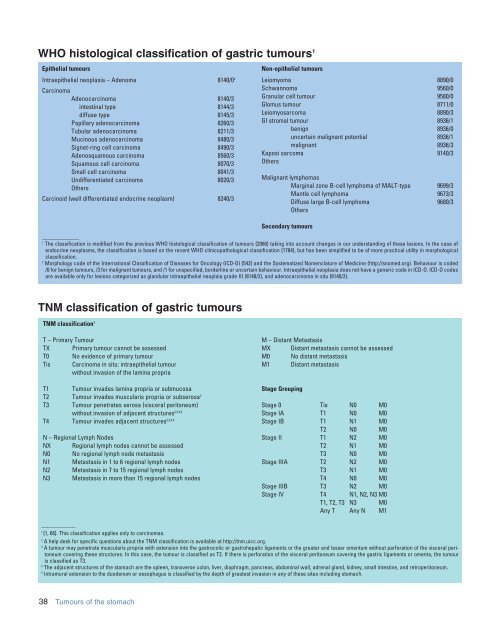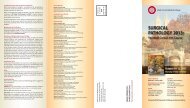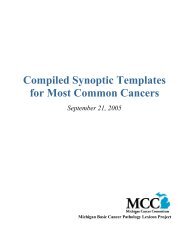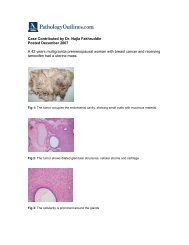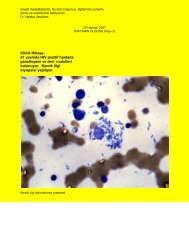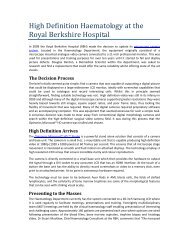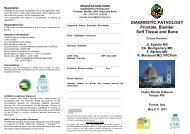CHAPTER 3 Tumours of the Stomach - Pathology Outlines
CHAPTER 3 Tumours of the Stomach - Pathology Outlines
CHAPTER 3 Tumours of the Stomach - Pathology Outlines
You also want an ePaper? Increase the reach of your titles
YUMPU automatically turns print PDFs into web optimized ePapers that Google loves.
WHO histological classification <strong>of</strong> gastric tumours 1<br />
Epi<strong>the</strong>lial tumours<br />
Intraepi<strong>the</strong>lial neoplasia – Adenoma 8140/0 2<br />
Carcinoma<br />
Adenocarcinoma 8140/3<br />
intestinal type 8144/3<br />
diffuse type 8145/3<br />
Papillary adenocarcinoma 8260/3<br />
Tubular adenocarcinoma 8211/3<br />
Mucinous adenocarcinoma 8480/3<br />
Signet-ring cell carcinoma 8490/3<br />
Adenosquamous carcinoma 8560/3<br />
Squamous cell carcinoma 8070/3<br />
Small cell carcinoma 8041/3<br />
Undifferentiated carcinoma 8020/3<br />
O<strong>the</strong>rs<br />
Carcinoid (well differentiated endocrine neoplasm) 8240/3<br />
Non-epi<strong>the</strong>lial tumours<br />
Leiomyoma 8890/0<br />
Schwannoma 9560/0<br />
Granular cell tumour 9580/0<br />
Glomus tumour 8711/0<br />
Leiomyosarcoma 8890/3<br />
GI stromal tumour 8936/1<br />
benign 8936/0<br />
uncertain malignant potential 8936/1<br />
malignant 8936/3<br />
Kaposi sarcoma 9140/3<br />
O<strong>the</strong>rs<br />
Malignant lymphomas<br />
Marginal zone B-cell lymphoma <strong>of</strong> MALT-type 9699/3<br />
Mantle cell lymphoma 9673/3<br />
Diffuse large B-cell lymphoma 9680/3<br />
O<strong>the</strong>rs<br />
Secondary tumours<br />
_____________<br />
1<br />
The classification is modified from <strong>the</strong> previous WHO histological classification <strong>of</strong> tumours {2066} taking into account changes in our understanding <strong>of</strong> <strong>the</strong>se lesions. In <strong>the</strong> case <strong>of</strong><br />
endocrine neoplasms, <strong>the</strong> classification is based on <strong>the</strong> recent WHO clinicopathological classification {1784}, but has been simplified to be <strong>of</strong> more practical utility in morphological<br />
classification.<br />
2<br />
Morphology code <strong>of</strong> <strong>the</strong> International Classification <strong>of</strong> Diseases for Oncology (ICD-O) {542} and <strong>the</strong> Systematized Nomenclature <strong>of</strong> Medicine (http://snomed.org). Behaviour is coded<br />
/0 for benign tumours, /3 for malignant tumours, and /1 for unspecified, borderline or uncertain behaviour. Intraepi<strong>the</strong>lial neoplasia does not have a generic code in ICD-O. ICD-O codes<br />
are available only for lesions categorized as glandular intraepi<strong>the</strong>lial neoplaia grade III (8148/2), and adenocarcinoma in situ (8140/2).<br />
TNM classification <strong>of</strong> gastric tumours<br />
TNM classification 1<br />
T – Primary Tumour<br />
TX Primary tumour cannot be assessed<br />
T0 No evidence <strong>of</strong> primary tumour<br />
Tis Carcinoma in situ: intraepi<strong>the</strong>lial tumour<br />
without invasion <strong>of</strong> <strong>the</strong> lamina propria<br />
T1 Tumour invades lamina propria or submucosa<br />
T2 Tumour invades muscularis propria or subserosa 2<br />
T3 Tumour penetrates serosa (visceral peritoneum)<br />
without invasion <strong>of</strong> adjacent structures 2,3,4,5<br />
T4 Tumour invades adjacent structures 2,3,4,5<br />
N – Regional Lymph Nodes<br />
NX Regional lymph nodes cannot be assessed<br />
N0 No regional lymph node metastasis<br />
N1 Metastasis in 1 to 6 regional lymph nodes<br />
N2 Metastasis in 7 to 15 regional lymph nodes<br />
N3 Metastasis in more than 15 regional lymph nodes<br />
M – Distant Metastasis<br />
MX Distant metastasis cannot be assessed<br />
M0 No distant metastasis<br />
M1 Distant metastasis<br />
Stage Grouping<br />
Stage 0 Tis N0 M0<br />
Stage IA T1 N0 M0<br />
Stage IB T1 N1 M0<br />
T2 N0 M0<br />
Stage II T1 N2 M0<br />
T2 N1 M0<br />
T3 N0 M0<br />
Stage IIIA T2 N2 M0<br />
T3 N1 M0<br />
T4 N0 M0<br />
Stage IIIB T3 N2 M0<br />
Stage IV T4 N1, N2, N3 M0<br />
T1, T2, T3 N3 M0<br />
Any T Any N M1<br />
____________<br />
1<br />
{1, 66}. This classification applies only to carcinomas.<br />
2<br />
A help desk for specific questions about <strong>the</strong> TNM classification is available at http://tnm.uicc.org.<br />
3<br />
A tumour may penetrate muscularis propria with extension into <strong>the</strong> gastrocolic or gastrohepatic ligaments or <strong>the</strong> greater and lesser omentum without perforation <strong>of</strong> <strong>the</strong> visceral peritoneum<br />
covering <strong>the</strong>se structures. In this case, <strong>the</strong> tumour is classified as T2. If <strong>the</strong>re is perforation <strong>of</strong> <strong>the</strong> visceral peritoneum covering <strong>the</strong> gastric ligaments or omenta, <strong>the</strong> tumour<br />
is classified as T3.<br />
4<br />
The adjacent structures <strong>of</strong> <strong>the</strong> stomach are <strong>the</strong> spleen, transverse colon, liver, diaphragm, pancreas, abdominal wall, adrenal gland, kidney, small intestine, and retroperitoneum.<br />
5<br />
Intramural extension to <strong>the</strong> duodenum or oesophagus is classified by <strong>the</strong> depth <strong>of</strong> greatest invasion in any <strong>of</strong> <strong>the</strong>se sites including stomach.<br />
38 <strong>Tumours</strong> <strong>of</strong> <strong>the</strong> stomach


